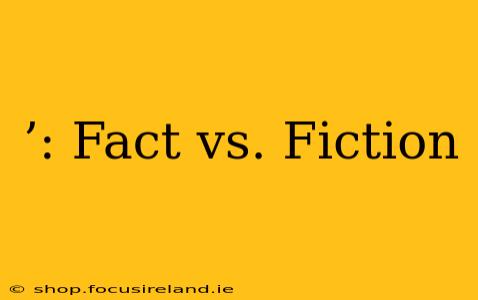The lines between fact and fiction are increasingly blurred in our modern world, saturated as it is with information from various sources—some reliable, many not. Distinguishing truth from untruth is a crucial skill, vital for navigating the complexities of daily life and informed decision-making. This article will delve into the characteristics of fact and fiction, explore common ways fiction masquerades as fact, and provide practical strategies for discerning truth from falsehood.
What Constitutes Fact?
A fact is a piece of information that can be objectively verified. It's based on evidence, supported by reliable sources, and can be independently confirmed. Facts are typically demonstrable, meaning they can be shown to be true through observation, experimentation, or credible documentation. For example, "The Earth is round" is a fact supported by centuries of scientific observation and evidence. In contrast, a statement like "The Earth is flat" is a fiction, contradicted by overwhelming evidence.
What Defines Fiction?
Fiction, on the other hand, is a narrative created from imagination, not necessarily based on reality. While fiction can be inspired by real events or people, it is ultimately a construct of the author's creativity. Fictional works like novels, short stories, and films are clearly identified as such. However, the problem arises when fiction is presented as fact, intentionally or unintentionally.
How Fiction Masquerades as Fact: Common Methods
The intentional or unintentional dissemination of fiction as fact is a pervasive issue. Here are some common methods:
Misinformation:
This involves the sharing of inaccurate information, often unintentionally. This can stem from misunderstandings, misinterpretations, or the propagation of rumors.
Disinformation:
This is the deliberate spread of false or misleading information, usually with malicious intent. The goal is often to manipulate public opinion, damage reputations, or sow discord.
Propaganda:
This involves the systematic dissemination of information designed to influence public opinion. Propaganda often employs emotionally charged language, biased reporting, and appeals to prejudice.
Fake News:
This refers to false or misleading information presented as news. Fake news articles often mimic legitimate news websites in their design and style, making them difficult to distinguish from real news.
How to Discern Fact from Fiction: Practical Strategies
Effectively separating fact from fiction requires a critical and discerning approach:
Evaluate the Source:
Is the source reputable? Is it known for accuracy and objectivity? Consider the source's history, bias, and potential motives.
Check Multiple Sources:
Don't rely on a single source. Consult multiple sources to corroborate information. Look for consistency across different reputable outlets.
Look for Evidence:
Does the information provided have supporting evidence? Are there credible sources cited? Be wary of claims lacking supporting evidence.
Identify Bias:
Is the information presented objectively or is there a clear bias? Be aware of emotional appeals and loaded language.
Consider the Context:
Does the information fit within a broader context? Does it align with established knowledge and understanding?
Frequently Asked Questions (FAQs)
How can I identify fake news websites?
Look for inconsistencies in design, grammar, and writing style. Check the website's "About Us" section for transparency and legitimacy. Search for the website or articles online to see if others have flagged them as unreliable.
What is the role of fact-checking websites in combating misinformation?
Fact-checking websites play a crucial role in verifying information and identifying misinformation. They provide independent analyses of claims and statements, helping individuals determine the accuracy of information they encounter.
What are some examples of how misinformation can have real-world consequences?
Misinformation can have serious consequences, ranging from influencing elections to harming public health. The spread of false information about vaccines, for instance, can lead to decreased vaccination rates and outbreaks of preventable diseases.
Conclusion
The ability to distinguish fact from fiction is more important than ever in our information-rich world. By cultivating critical thinking skills and employing the strategies outlined above, we can navigate the complexities of the modern information landscape and make informed decisions based on truth, not deception. Remember, questioning information and seeking reliable sources are essential steps in this crucial process.

